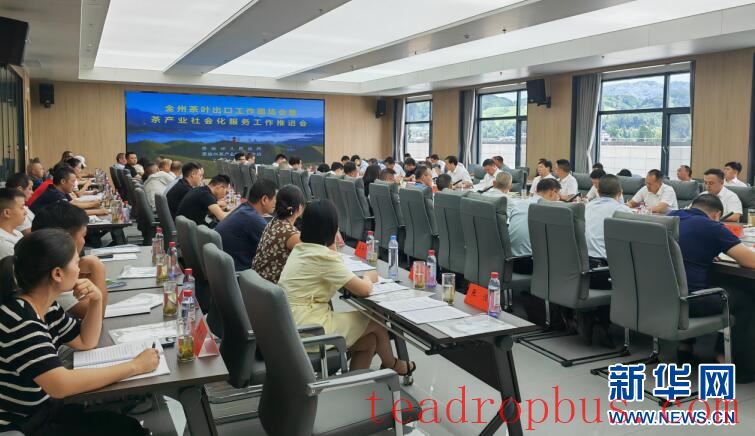“In 2025, ‘Enshi Selenium-rich Tea' saw direct exports of 13,000 tons, accounting for 54% and 3.5% of Hubei Province's and China's total tea exports, respectively; the export value reached 410 million yuan, representing 29.1% and 3.2% of the province's and nation's tea export values, respectively…” These impressive export figures for Enshi Selenium-rich Tea were presented at the Hubei Province Enshi Prefecture Tea Export Work Conference on July 30th, greatly encouraging those in the Enshi tea industry and further solidifying the confidence in bulk tea exports from the Enshi Prefecture.

Photo taken at the Enshi Selenium-rich Tea export work conference. Photo by Hu Xingming (Xinhua Net)
“Adapting to the new development pattern of dual circulation within domestic and international markets, we are leveraging our advantages to propel Enshi Selenium-rich Tea into global markets, expanding and consolidating its international presence, and driving the high-quality development of the Enshi tea industry through bulk tea exports.” Deputy Prefectural Governor Yang Shengliao explained that pushing bulk tea exports is a critical and practical move made by the Enshi Prefectural Committee and government in response to complex circumstances.
It is known that the Enshi Prefecture has 1.82 million mu of tea gardens, ranking first in the province and fourth among prefecture-level tea-producing regions in China. Among these, He Feng County has established a 240,000-mu raw material base for export teas, while Xuan'en County has built a 40,000-mu tea export filing base.
In recent years, the Enshi Prefecture has focused on cultivating and attracting leading tea enterprises, transitioning from individual efforts to a collective approach, creating a matrix effect. Kai Rong Industrial Company in He Feng County is the largest Zhejiang tea investment in Hubei. While achieving significant growth itself, it effectively empowers the He Feng tea industry to cluster and grow. Last year, this company generated foreign exchange earnings of 32 million USD, with expectations to reach 50 million USD this year, firmly placing it as the top earner in the Prefecture and among the leaders in the province. Wu Tai Changchen Tea Industry in Xuan'en County is a local enterprise with an annual output exceeding 100 million yuan, over 70% of which comes from exports. Collaborating with 38 entities, it radiates across five local towns, benefiting more than 40,000 tea farmers.
In the past, most of Enshi's bulk tea was summer and Autumn Tea. Without market demand, much of it would be left unharvested. Wang Bo, Party Secretary and Director of the Enshi Prefecture Department of Agriculture and Rural Affairs, said that by promoting bulk tea exports, the yield and economic value per unit area of tea gardens can be significantly increased, effectively boosting farmers' incomes and turning what used to be abandoned tea into a valuable commodity. In 2025, the Enshi Prefecture directly or indirectly exported 40,000 tons of bulk tea for a revenue of 850 million yuan, increasing household income by an average of 3,137 yuan.

Photo of the He Feng export tea industrial base. Photo by Liu Qiangsheng (Xinhua Net)
Notably, the process of exporting Enshi Selenium-rich Tea across mountains and seas has become increasingly convenient. The successful opening of the Enshi-Ningbo Zhoushan Port rail-sea intermodal channel has created a new export route to the southeast coastal region, allowing Enshi tea to be transported “in one container all the way to its final destination.” Compared to the previous rail-sea intermodal transport from the Yichang station, transportation time has been reduced by five hours, and the comprehensive transportation cost per container has decreased by 2,800 yuan.
According to reports, the current main destinations for Enshi tea exports are countries and regions in Africa, the Middle East, and Central Asia, where the overall profit margins have room for improvement, particularly in markets such as Europe, America, Japan, South Korea, and Australia, which hold great potential for expansion. How can Enshi Selenium-rich Tea turn its resource advantages into development advantages? Deputy Prefectural Governor Yang Shengliao explains that it requires sustained effort, strengthening both product quality and marketing efforts domestically and internationally, leveraging the leading role of key enterprises, and comprehensively improving the quality and efficiency of bulk tea exports.
“We always adhere to a problem-oriented, goal-oriented, and results-oriented approach, fully advancing the out-of-province sales of premium teas and the overseas export of bulk teas,” says Wu Jianqing, Chairman of the Enshi Prefecture CPPCC and head of the Prefecture's tea industry chain. He states that they will focus on building trading markets, industry services, and supply chain platforms to increase the income of tea farmers and improve the efficiency of tea companies, accelerating the pace of building a strong tea industry in the Prefecture.
(Contributed by Hu Xingming, Yang Yan)